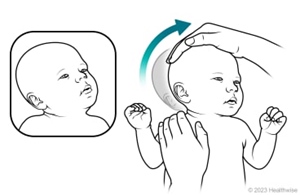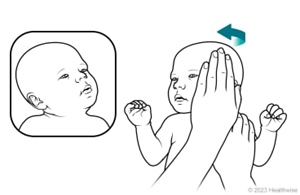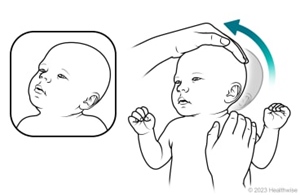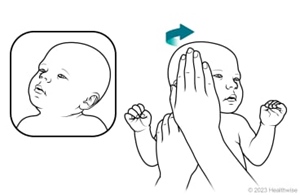Congenital Torticollis: Exercises
Introduction
Here are some examples of exercises for torticollis that you can do for your baby. Do them gently and slowly.
These are general instructions. Your doctor or physical therapist will tell you when you can start these
exercises, how to do them, and which ones will work best for your baby.
Do the exercises several times each day. For example, some people do them at each diaper change.
It can be hard to do exercises with a baby. Your baby may move and squirm or cry. But doing them may help the
baby get better. If you are unsure how to do the exercises or think you are hurting your baby, talk to your
doctor.
Right torticollis: How to do the exercises
Right torticollis stretch

If your baby's head tilts to the right and the chin points up to the left:
-
Place your baby on their back on a changing table or a carpeted floor.
-
Place one hand on your baby's right shoulder. This holds the shoulder down.
-
Put your other hand on top of your baby's head.
-
Gently and slowly bend your baby's head toward your baby's left shoulder.
-
Try to hold the position for at least 2 seconds. Then slowly let the head return to its resting
position.
-
Repeat 2 or 3 times.
You can also do this stretch by sitting your baby on your lap, facing away from you. To hold your baby's
shoulders steady, put one of your arms across both of the baby's shoulders and hold the baby against your
body. Then follow steps 3 through 6.
Right torticollis rotation

If your baby's head tilts to the right and the chin points up to the left:
-
Place your baby on their back on a changing table or a carpeted floor.
-
Put one hand on your baby's left shoulder. This holds the shoulder down.
-
Put your other hand across the left side of your baby's face (from the forehead to the chin).
-
Gently and slowly rotate your baby's face toward your baby's right shoulder.
-
Try to hold the position for at least 2 seconds. Then slowly let the head return to its resting
position.
-
Repeat 2 or 3 times.
You can also do this stretch by sitting your baby on your lap, facing away from you. To hold your baby's
shoulders steady, put one of your arms across both of the baby's shoulders and hold the baby against your
body. Then follow steps 3 through 6.
Left torticollis: How to do the exercises
Left torticollis stretch

If your baby's head tilts to the left and the chin points up to the right:
-
Place your baby on their back on a changing table or a carpeted floor.
-
Put one hand on your baby's left shoulder. This holds the shoulder down.
-
Put the other hand on your baby's head.
-
Gently and slowly bend your baby's head toward your baby's right shoulder.
-
Try to hold the position for at least 2 seconds. Then slowly let the head return to its resting
position.
-
Repeat 2 or 3 times.
You can also do this stretch by sitting your baby on your lap, facing away from you. To hold your baby's
shoulders steady, put one of your arms across both of the baby's shoulders and hold the baby against your
body. Then follow steps 3 through 6.
Left torticollis rotation

If your baby's head tilts to the left and the chin points up to the right:
-
Place your baby on their back on a changing table or a carpeted floor.
-
Put one hand on your baby's right shoulder. This holds the shoulder down.
-
Put your other hand across the right side of your baby's face (from the forehead to the chin).
-
Gently and slowly rotate your baby's face toward your baby's left shoulder.
-
Try to hold the position for at least 2 seconds. Then slowly let the head return to its resting
position.
-
Repeat this 2 to 3 times.
You can also do this stretch by sitting your baby on your lap, facing away from you. To hold your baby's
shoulders steady, put one of your arms across both of the baby's shoulders and hold the baby against your
body. Then follow steps 3 through 6.
Follow-up care is a key part of your child's treatment and safety. Be sure to make and go to all
appointments, and call your doctor if your child is having problems. It's also a good idea to know your
child's test results and keep a list of the medicines your child takes.
Current as of: July 17, 2023
Content Version: 14.0
Care instructions adapted under license by your
healthcare professional. If you have questions about a medical condition or this instruction, always ask
your healthcare professional. Healthwise, Incorporated disclaims any warranty or liability for your use of
this information.